Sedum Rock - features of cultivation
The sedum is rocky, or bent, belongs to the succulents of the same genus. Part of the Tolstyankov family. Originally from Northern, Southeastern and Central Europe. In Russia, it grows in the western regions and is found in the north of the Caucasus. Found application in private floriculture. It is used as a seasoning or to decorate the site.
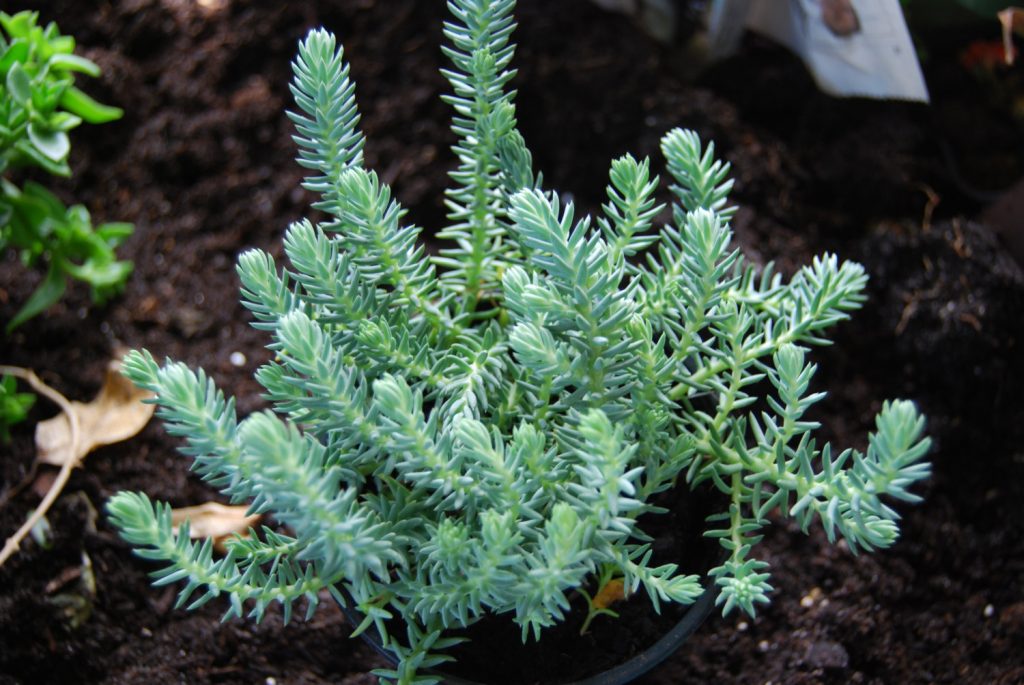
Sedum rock photo
Botanical characteristic
The botanical name is Sedum reflexum.
Perennial evergreen, ornamental, creeping, height - 15-25 cm. The flowering period occurs at the end of June-July, duration is about two to three weeks. Forms curtains and creeping rugs of the order of 20 cm.
In a number of countries, sedum is considered edible and is used for culinary purposes for making soups and sauces for salads. Has an astringent taste with a sour aftertaste.
External description:
- leaves are located on creeping shoots, the color is green, sometimes with a blue or reddish tint, the surface is smooth, the structure is fleshy, intended for the accumulation of moisture reserves;
- creeping root, horizontal arrangement, hardens as the plant develops;
- the flowers are bright yellow, about 1.5 cm in size, initially dense, the shape of the petals is lanceolate, with pointed ends.
Similar plants:
- sedum caustic, similar to the pointed shape of leaves, height about 12 * 15 cm;
- ground plant, has a similar creeping type of development, formed by thickened foliage with a bluish tint;
- bastard pseudo-lava-shaped, grows in the form of a dense branched bush with narrow sparse bright green leaves.
Varieties
In private floriculture, several varieties of bent sedum are grown.
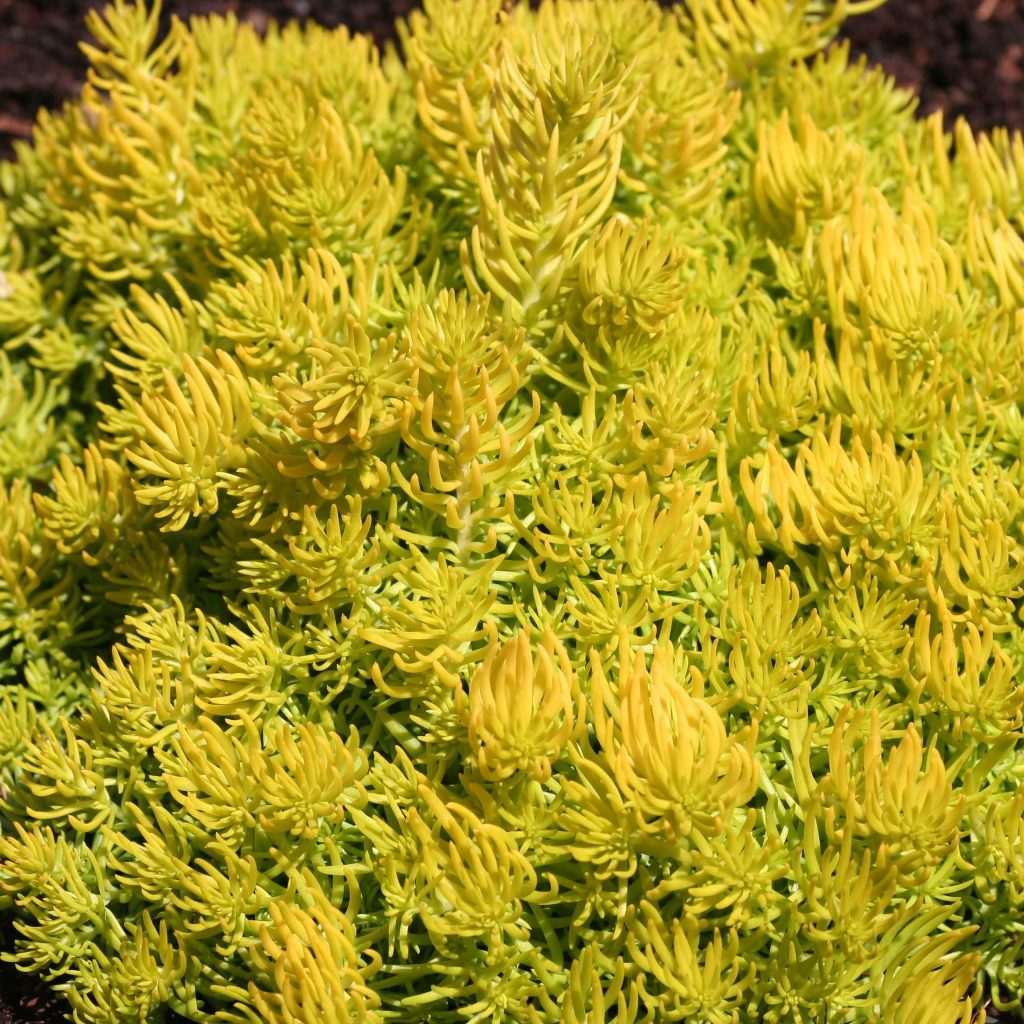
Sedum reclined
- Kristatum (Cristatum). People call it "Cock's comb" for its unusual appearance: thickened stems are densely covered with closely spaced bright green foliage, reminiscent of coniferous needles. In the fall, it becomes red. Shoots on the surface of the soil form a thick wavy carpet. It blooms with bright yellow flowers in the middle of years. Prefers a sunny place, copes well with heat. Frost resistant.
- Glaucum. It has another name - Lydian. The leaves are small, twisted in shape, the color is gray-green. Plant height up to 5 cm. Differs in intensive growth, in a short period of time forms a creeping dense turf. The foliage is narrow, up to 5-6 mm long, gray-blue, sometimes with a reddish tint. It blooms in mid-June with white flowers, which turn pink by the end of the flowering phase. It develops well both in sunlit places and in shaded areas. Susceptible to stagnant water.
- Angelina (Angelina). Among other varieties, it stands out for the golden color of needle-like leaves, which acquire an orange tint when autumn comes. Height up to 15 cm. Blossoms in July with yellow inflorescences.It is often grown in compositions for decorating and strengthening slopes. Resistant to drought and cold temperatures.
- Sandy Silver Crest. Differs in a green-purple shade of short-needle foliage. It grows slowly, rarely found in floriculture. Shoots branch out at the base to form lush shrubs. It is more often cultivated as an indoor flower.
- Sea Gold. Slow growing variety with elongated, narrow leaves of light green color, which acquire a lilac hue in summer. More often grown in pots. Frost resistant.
- Blue Forest. A lush succulent plant about 20 cm tall with juicy bluish leaves. Differs in abundant flowering. Inflorescences are spherical, yellow. Grows well in open conditions.
Purchase and adaptation
When buying a plant, you need to inspect it. In a healthy sedum:
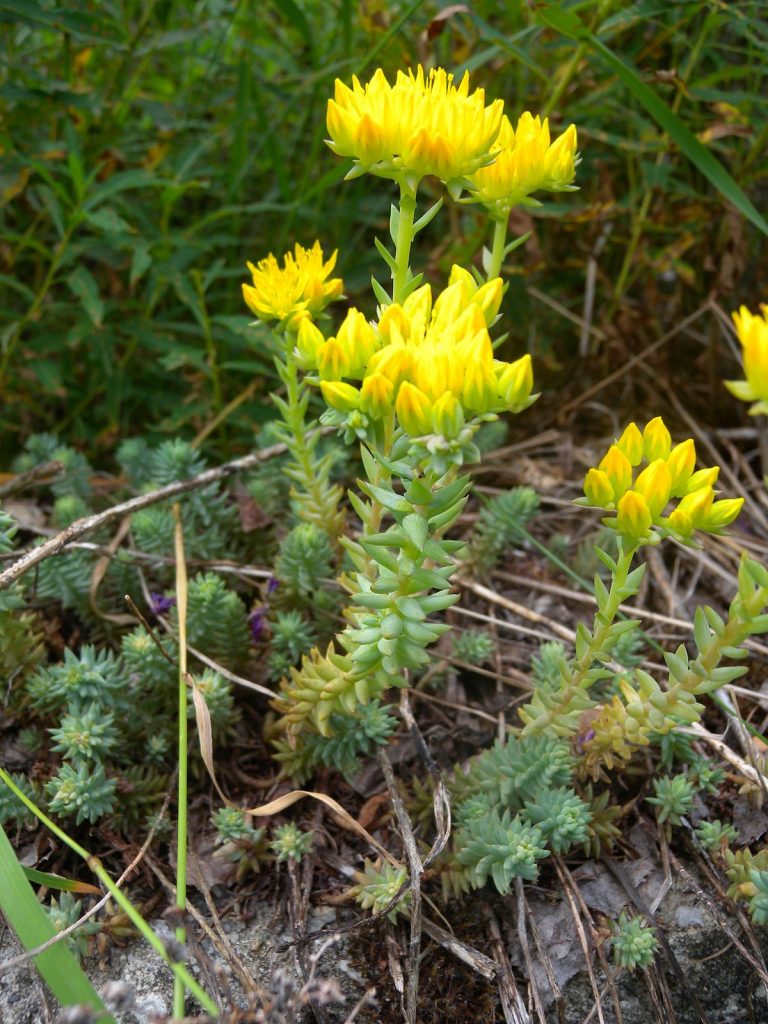
Sedum folded photo
- there are no spots on the foliage;
- rich leaf color, shade in accordance with the variety;
- roots without damage.
When planting in open ground, it does not require an adaptation period. When planted at home, it is quarantined for weeks.
Landing rules and soil requirements
In the wild, it grows on poor sandy and stony soils, including on railway embankments, in pine forest belts. Compactness and short stature allows you to successfully grow stonecrop at home (in pots, on balconies and terraces).
When growing sedum indoors, preference should be given to the southern and southeastern directions.
For a succulent, a loose and light soil is suitable, which is well permeable to water and has increased air permeability. Before planting, the bottom of the potting container is laid out with drainage - coarse sand, foam, expanded clay or broken brick.
The soil mixture can be made independently from equal shares of leaf and turf soil and sand mixture.
For growing indoors, choose shallow wide pots made of clay and ceramics (without a glazed outer coating, the porous walls of which are good for moisture and air).
When planting in the garden, the distance between the bushes is 0.2 or more meters.
The necessary conditions
Sedum Bent down develops well when organizing minimal comfortable conditions, but for full development it requires sufficient space.
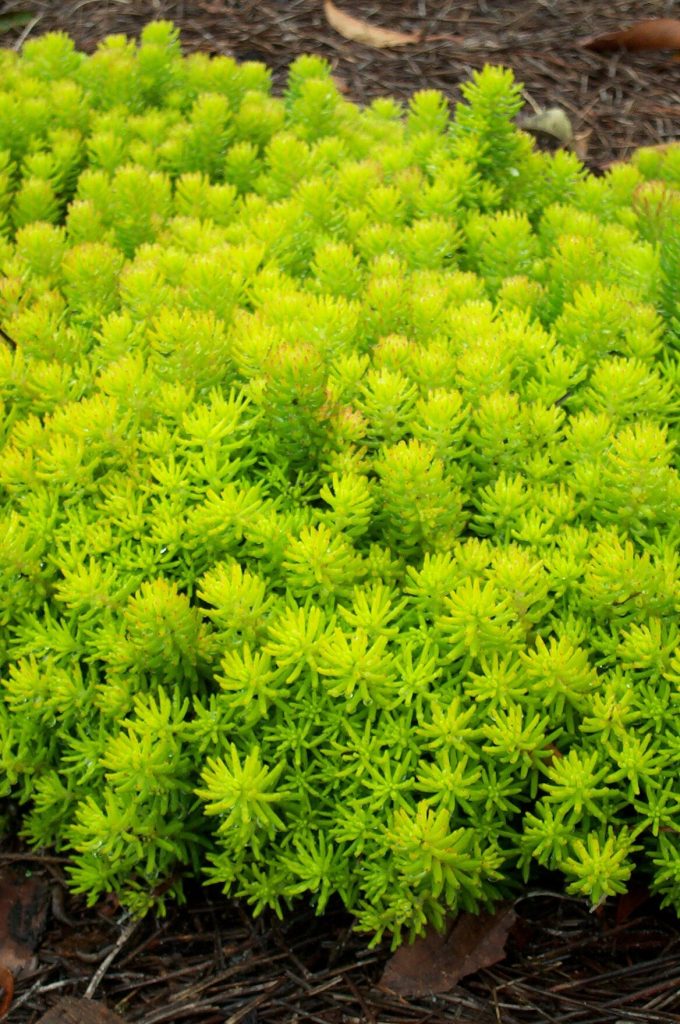
Sedum reclined cristatum
Moisture readings are not critical. However, you should not place the flowerpot near heating appliances.
The plant easily tolerates heat. Possesses average frost resistance, withstanding temperature drops up to 7 ° С. The optimal regime in summer is 25 ° С, in winter - 12 ° С.
To maintain decorativeness, it needs constant lighting and direct sunlight.
Care
Top dressing
Sedum is fed during the active growing season. The frequency of top dressing is once every 1-2 months. Mineral complexes developed for succulents are suitable for fertilization.
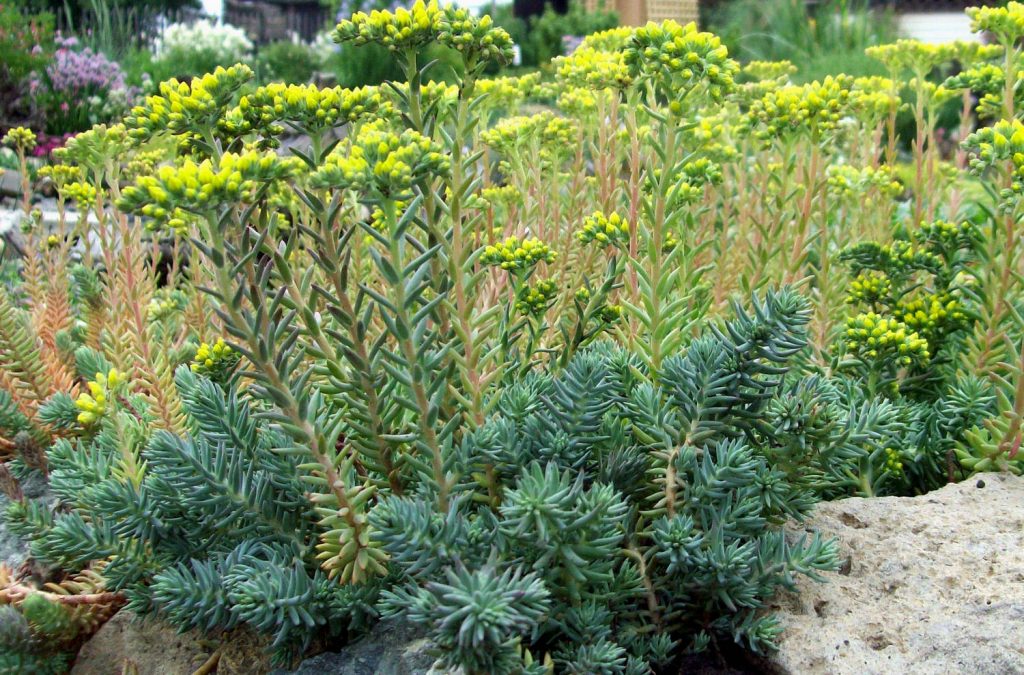
Sedum bent blue forest
Fortified nutrition adversely affects the decorative effect of the flower culture, especially on varieties with yellow and red foliage, which acquire a classic green color.
Watering
The flower culture is susceptible to moisture stagnation. The basic rule when organizing irrigation of a succulent is complete drying out of the soil, in which drought is preferable instead of overflow.
Optimal watering regime:
- in summer - up to 2 times a month;
- in winter - no more than once every 1.5 months.
In order to cleanse the accumulated dust in the summer, spraying on foliage is shown.
Transfer
Young plants with a developing root system when grown at home are transplanted annually, providing sufficient space.
For adult succulents, the pot and soil are replaced every 3-4 years. For old sedums, they are limited to replacing the surface layer of the substrate to a depth of about 5 cm.
Formation
Usually sedum is not formed.Dry peduncles are subject to pruning, which are cut at the root, as well as too elongated shoots, dried stems and leaves.
Anti-aging procedures begin from 3-4 years old.
Reproduction methods
At home, stonecrop is propagated by cuttings, seeds and dividing the bush.
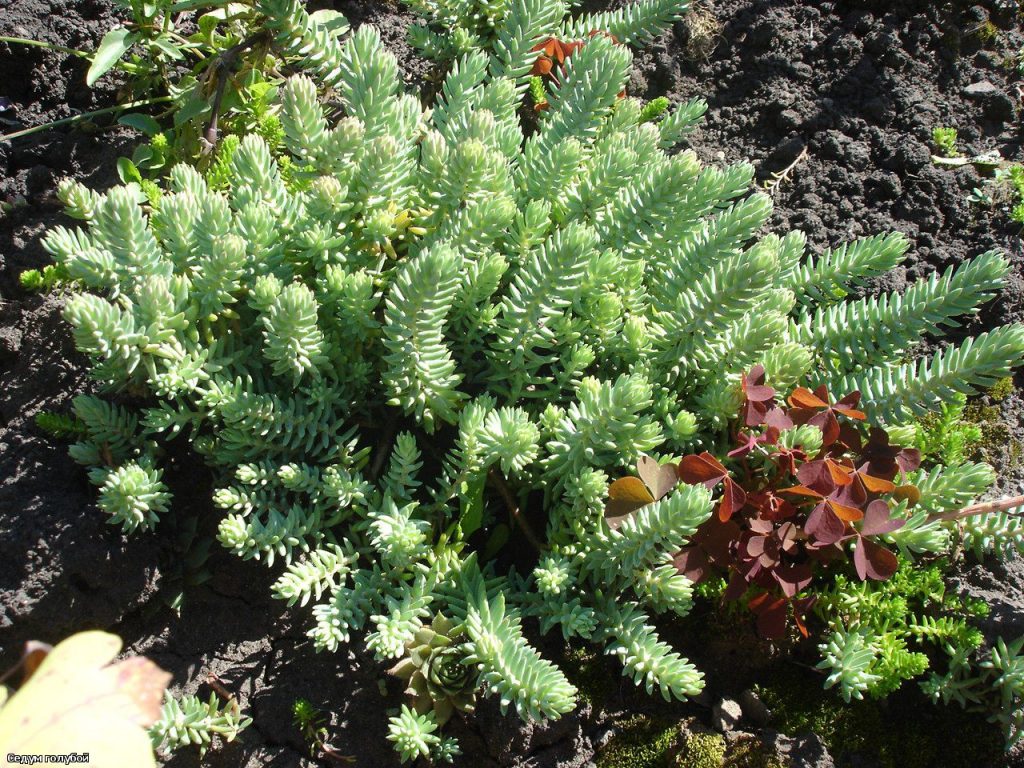
Sedum reflexum cristatum
Seminal
The most laborious method of propagation, it gives low results and allows you to get new varieties. Requires the creation of greenhouse conditions.
Technology:
- seeds are distributed over the surface of the soil without deepening;
- sprinkle the sowing with sand on top and cover with polyethylene or glass, providing a greenhouse effect;
- the greenhouse is regularly ventilated, the substrate is moistened with a spray bottle.
Initially, the temperature is maintained at no more than 5 ° С, after 2 weeks the containers are moved to a warmer place - 15 ° С-18 ° С.
After 3 weeks, the seedlings dive into separate pots. If you intend to plant sprouts in open ground, they are pre-tempered, taking them out for 7-10 days to fresh air, starting from 1-2 hours, gradually increasing the residence time.
Cuttings
The most common breeding method. Shows a high rooting rate. The period is June-September. More often, those processes that remain after pruning are taken for breeding. Cuttings can also be prepared from the top of the shoots.
For rooting, a soil mixture is prepared from sand and peat, taken in equal proportions.
Dividing the bush
The bush is renewed every 4-5 years from the moment of planting. For division, the mother plant is divided into parts so that the delenka has a stem and several root shoots.
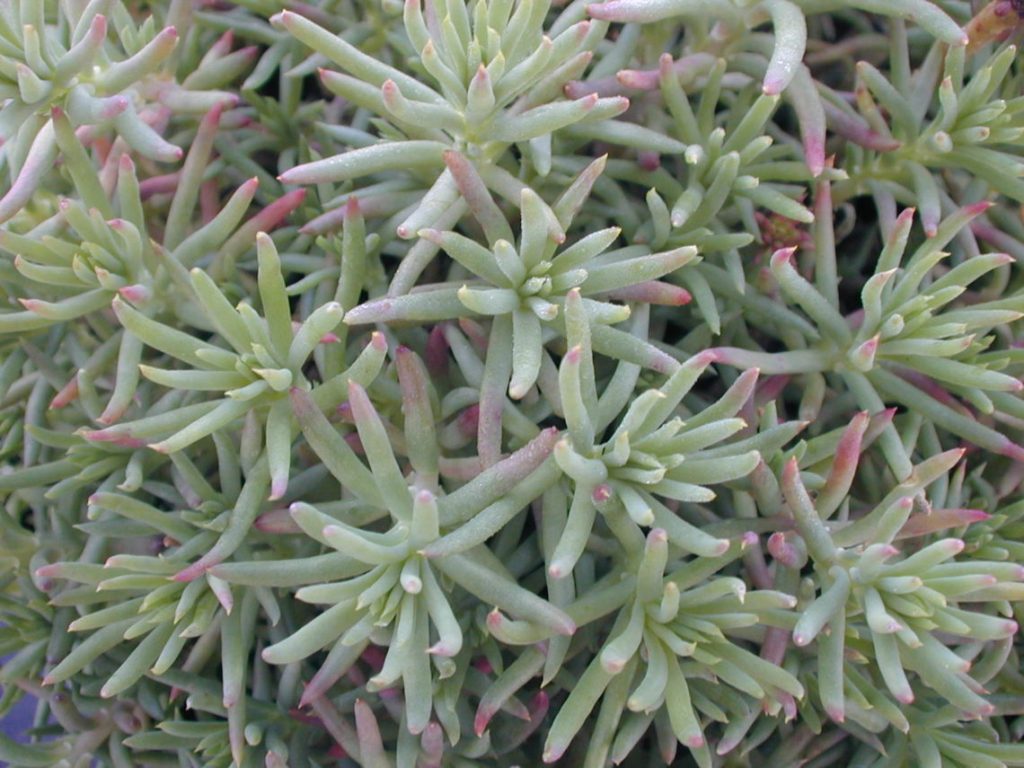
Sedum folded photo
The cut sites are treated with a fungicide or a weak solution of potassium permanganate. Delenki are dried naturally for 5-6 hours and planted for rooting.
Treatment of diseases and pests
Most often, sedum suffers from a violation of the rules of care.
| Type of defeat | Control methods |
| The stems are extended. The foliage loses its color, turns pale, thins, falls off. Caused by lack of lighting. | The plant is rearranged in a place well-lit by the sun, or supplementary lighting is provided. |
| The leaves swell. The bush takes on a weighted shape. It occurs due to an excess of nitrogen-containing fertilizers. | The nitrogen addition is stopped. Replacing it with compositions. Containing potassium and phosphorus. |
| Spots appear on the leaf plates. The roots are rotting. Signs of gray and root rot. The result of overflow and stagnation of moisture. | Watering is stopped. Sick foliage is cut off. The plant is removed from the pot. The affected areas of the root system are cut off, the survivors are treated with a weak solution of potassium permanganate or a fungicide. The flower is transplanted into a fresh substrate. Watering is resumed 3 days after transplanting. |
| Nematoda and weevil. | The flower culture is sprayed with an insecticide. |

